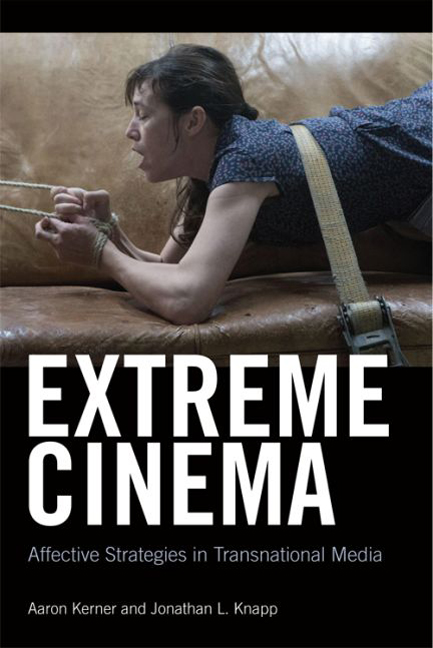Book contents
- Frontmatter
- Contents
- List of Figures
- Acknowledgments
- 1 Extreme Cinema: Revisiting Body Genres
- 2 Hearing: With a Touch of Sound—The Affective Charge of Audio Design
- 3 Pain: Exploring Bodies, Technology, and Endurance
- 4 Laughter: Belly-aching Laughter
- 5 Arousal: Graphic Encounters
- 6 Crying: Dreadful Melodramas—Family Dramas and Home Invasions
- 7 The End of Extreme Cinema?
- Bibliography
- Filmography
- Index
3 - Pain: Exploring Bodies, Technology, and Endurance
- Frontmatter
- Contents
- List of Figures
- Acknowledgments
- 1 Extreme Cinema: Revisiting Body Genres
- 2 Hearing: With a Touch of Sound—The Affective Charge of Audio Design
- 3 Pain: Exploring Bodies, Technology, and Endurance
- 4 Laughter: Belly-aching Laughter
- 5 Arousal: Graphic Encounters
- 6 Crying: Dreadful Melodramas—Family Dramas and Home Invasions
- 7 The End of Extreme Cinema?
- Bibliography
- Filmography
- Index
Summary
The unleashed desire to kill that we call war goes far beyond the realm of religious activity. Sacrifice though, while like war a suspension of the commandment not to kill, is the religious act above all others.
— Georges BatailleINTRODUCTION: TORTURE CHAMBERS, TORTURE PORN, AND THE NOSTALGIA FOR BODIES
The torture chamber is a common trope associated with the American torture porn cycle. A space specifically designed for the execution of pain is also present in many extreme films. The cinematic torture chamber—like the spaces used for sacred rituals—is frequently associated with the transformation of a character. The torture chamber tends to be a hermetic space, and more than this a non-place, sequestered from the day-to-day civilized world— what Michel Foucault called a heterotopia. Set in contrast to Utopias, heterotopias are “sites with no real place”; they exist contiguous with the inhabited world, and yet are set apart, sequestered.
In the spirit of earlier generic horror conventions, the torture chamber can also be read as an uncanny site, along the lines of the haunted house, or “terrible place.” Interestingly, Evangelos Tziallas observes that torture porn replaces horror's (and particularly the slasher film's) typical preoccupation with phallic weapons with “the overwhelming presence of ‘vagina dentata’ or ‘vaginal weaponry.’” The torture chamber threatens to (re)absorb the body, to consume it, and in that sense returns us to the site of the generative mother.
In torture porn the torture chamber-cum-womb witnesses the transformation of characters as (perverse) paternal agents—and they generally emerge, like a baby, from the monstrous site bloody, gasping, and crying. In extreme cinema, characters very well might emerge transformed, and surface from their ordeal like a gangly baby, but more often than not they are completely wrecked subjects. The Human Centipede ultimately produces a (dying) “centipede,” and Frontier(s) concludes with Yasmine's blood-drenched spasmodic walk. In Martyrs Lucie is wracked with haunting visions and Anna is brought to the threshold of life and death, while Milos in A Serbian Film destroys everything he loves.
The cinematic torture chamber is the stage upon which painful spectacles are executed—and the excesses of these violent pageants generally overwhelm conventional narrative regimes.
- Type
- Chapter
- Information
- Extreme CinemaAffective Strategies in Transnational Media, pp. 45 - 71Publisher: Edinburgh University PressPrint publication year: 2016



